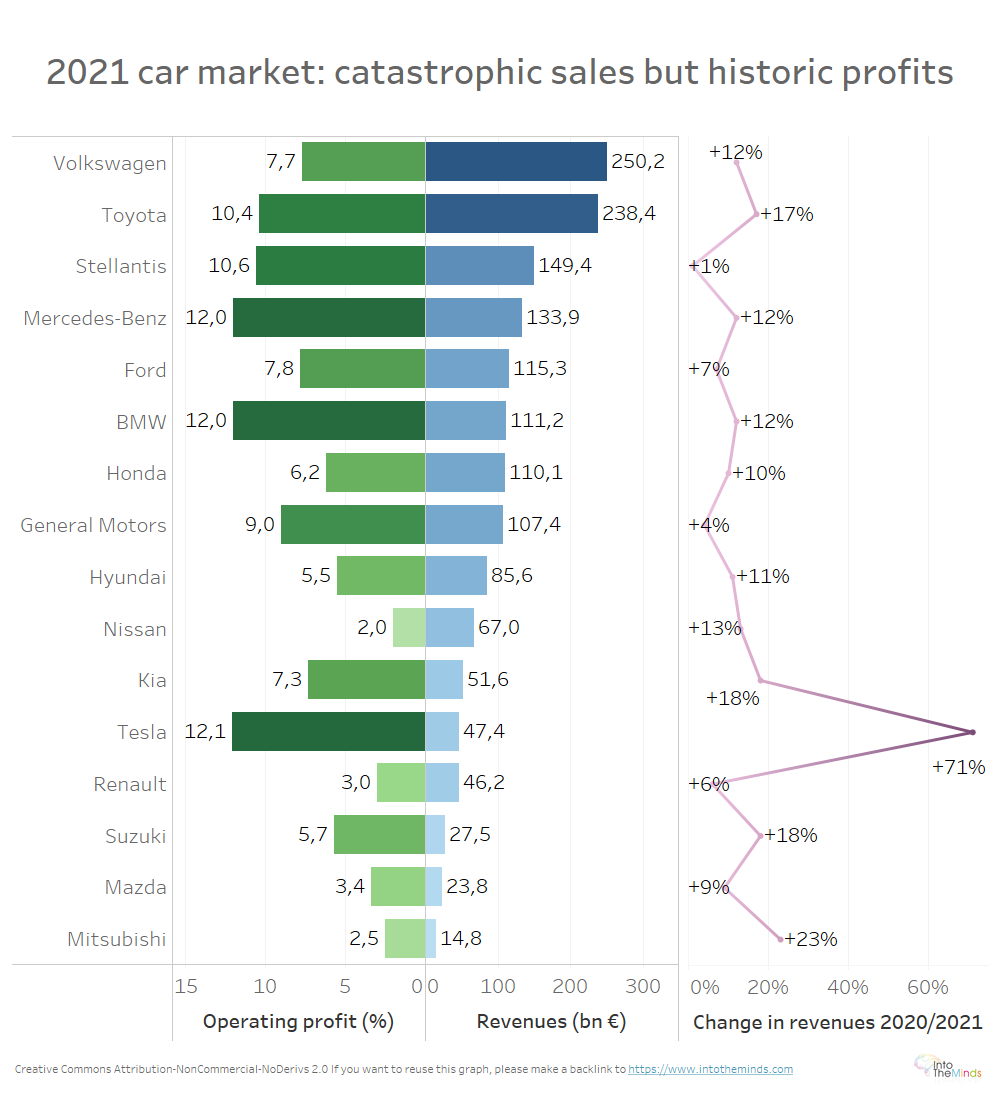Is the automobile market really in crisis? Sales have collapsed in the wake of Covid, inflation, and telecommuting. But paradoxically, car manufacturers’ profits have never been higher. For example, Stellantis’ sales fell 12% in volume between 2020 and 2021, but its profits rose 12%. How can we explain that car manufacturers’ profit margins have exploded between 2020 and 2021?
The Automobile Market Statistics 2021
- -14%: the decline in new vehicle sales between 2019 and 2020
- +5%: the increase in new vehicle sales between 2020 and 2021
- 134 billion: the profits of Western carmakers in 2021 (+168% compared to 2020)
- 8.5%: the average margin of the world’s top 16 automakers in 2021 (3.5% in 2020)
- Tesla is the champion of profitability with 12.1 billion Euros in profits for ‘only’ 47.4 billion Euros in sales
- +71%: the increase in Tesla’s turnover between 2020 and 2021
- -7%: the decrease in R&D expenses between 2020 and 2021
- -24%: the decrease in new car sales in Europe over the last 12 months
Stellantis: -12% of vehicles sold, +12% of profits!
The case of Stellantis is a perfect example of the singular character of the year 2021 for car manufacturers. Its turnover increased by 12%, while volumes decreased by 12% at the same time. This means that Stellantis has managed to raise its prices.
Stellantis Group has relied on its higher-end vehicles to compensate for the problems with semiconductors. As a result, the average price of the vehicles sold has increased. Coupled with a general increase in list prices, the increase in margins was spectacular.
This particular situation also corresponds quite well to the strategy of Carlos Tavares. He is calling for a general move upmarket and an improvement in the product mix.
To remember: 3 factors that contributed to an exceptional year
- The shortage of semiconductors has mechanically reduced the supply
- Demand, despite the structural decline, has become much higher than supply, allowing price increases to be passed and the widespread dealer discounting policy to be stopped
- Structural cost-saving measures initiated by manufacturers in 2020 to address Covid supported profitability in 2021
Semiconductors reserved for the most profitable cars
Paradoxically, the shortage of semiconductors has been a real opportunity for manufacturers. They adapted their product mix by favoring the most expensive models. With more significant means, the target consumers accepted the price increases without flinching.
The production lines that were still open were thus able to run on a just-in-time basis. This optimized the distribution of fixed costs to the maximum. This unique situation has led all car manufacturers to experience higher demand than supply.
The year 2021 was the year of transition from a volume model to a value model.
The effect of rationalization measures taken in 2020
The enormous efforts made in 2020 to optimize the cost structure have also paid off. Faced with the suddenness of the Covid crisis, car manufacturers had to take drastic measures to ensure their survival. The unprecedented 14% drop in registrations in 2020 threatened the very survival of some brands.
R&D and production costs have been drastically reduced. Distribution policies have also been reviewed, and in 2022 we are witnessing changes never seen before. Manufacturers are abandoning distribution via dealerships and want better control of their networks and contacts with end customers.
Can car manufacturers’ profitability hold up in 2022?
The big question for financial analysts is whether the feat of 2021 can be repeated in 2022. The boss of Stellantis said on May 5, 2022, during the presentation of its results, aiming for a double-digit margin in 2022. The goal of Stellantis is to reach 200 billion Euros by 2024. This would bring the group closer to Volkswagen and Toyota, the unbeatable leading duo. However, we must be extremely cautious because 2022 will not be like 2021.
Over the last 12 months, sales in Europe have fallen by 24%. We are therefore witnessing an irreversible shift in consumer spending. The war in Ukraine, the slowdown of production in China, the even more severe blockage of maritime flows, and low household morale will further push sales down. And those who need a car will turn to the second-hand market, the big winner of the crisis.
Posted in Strategy.
